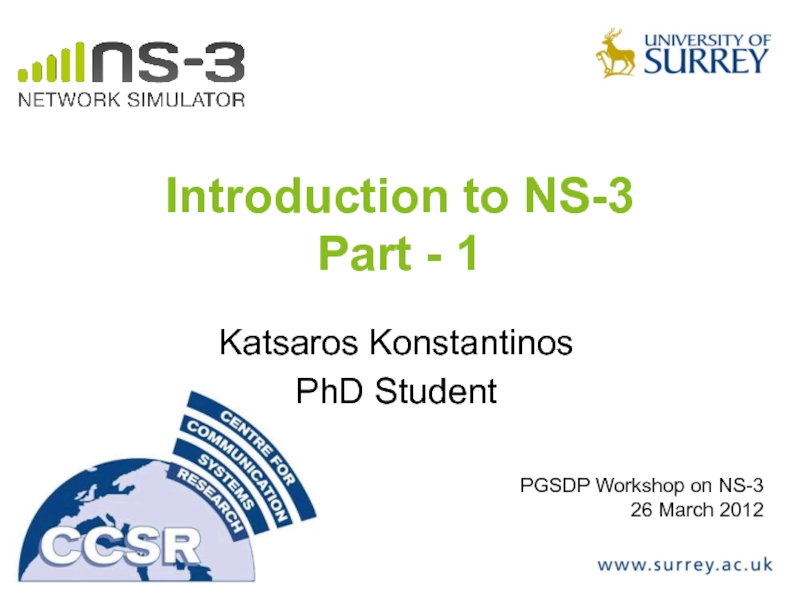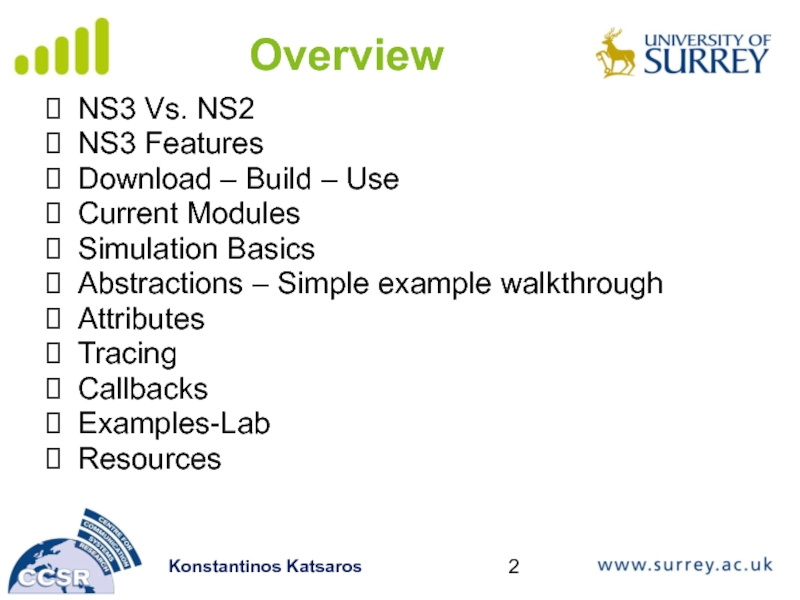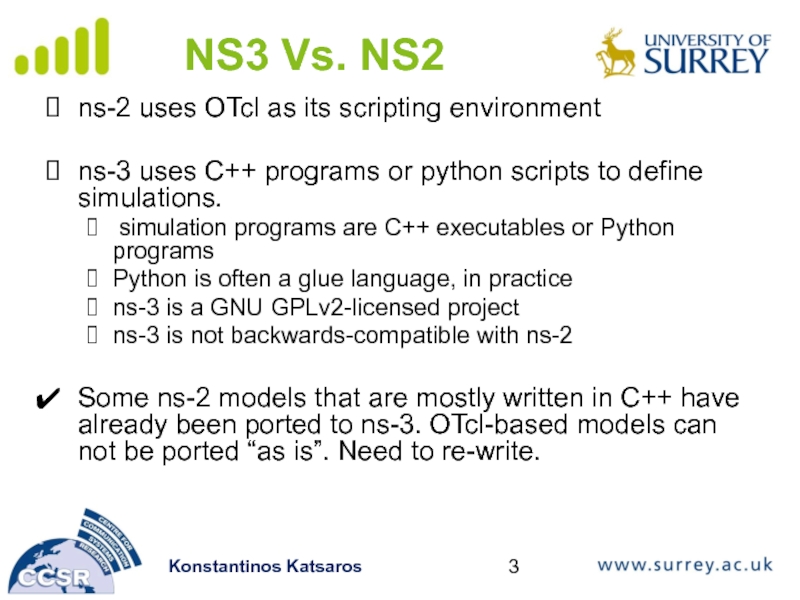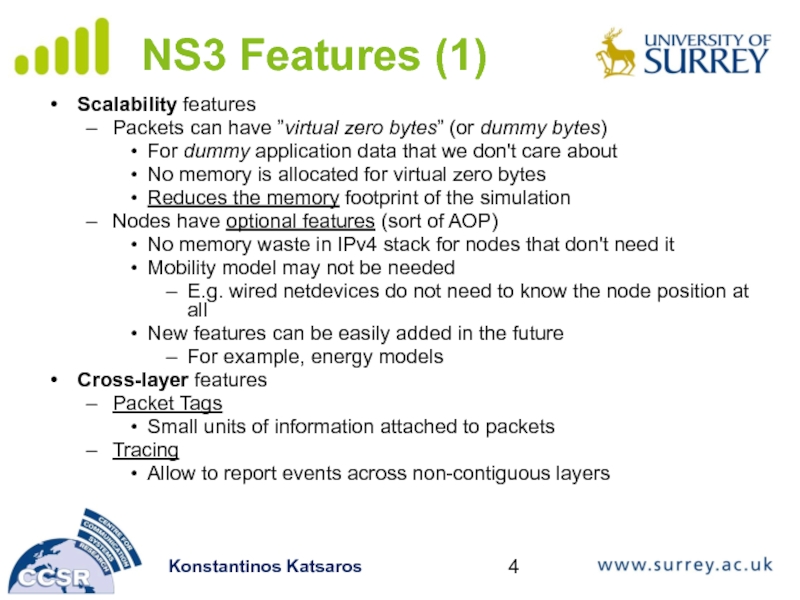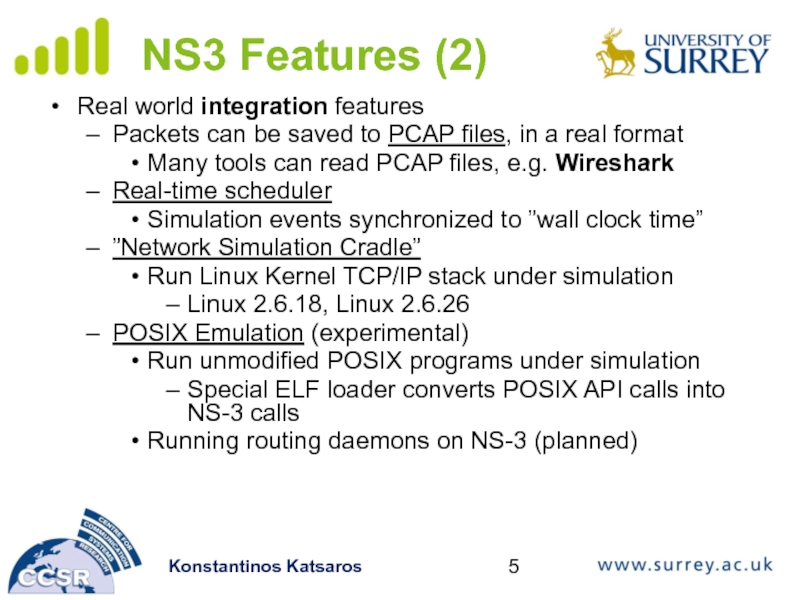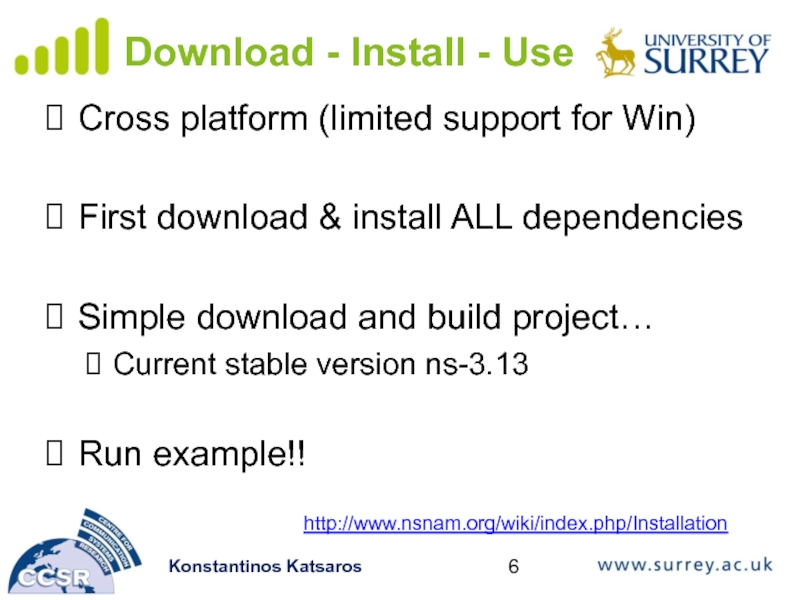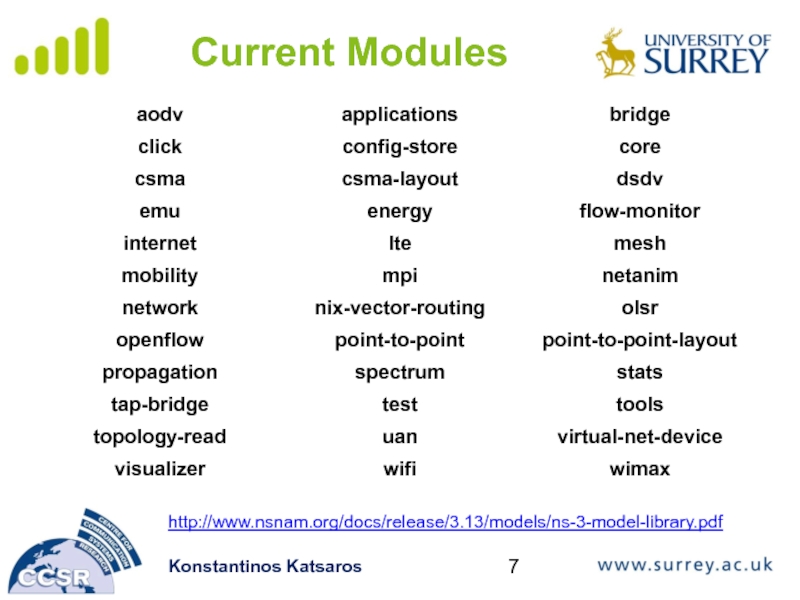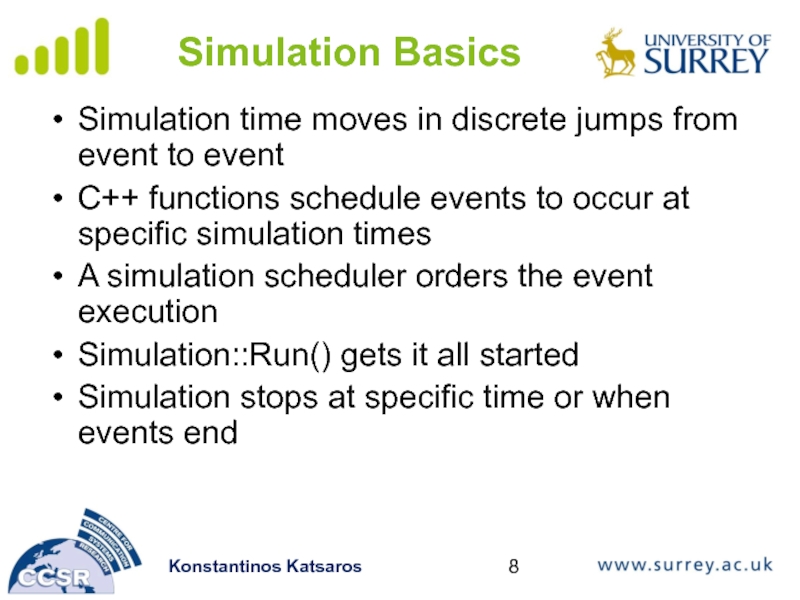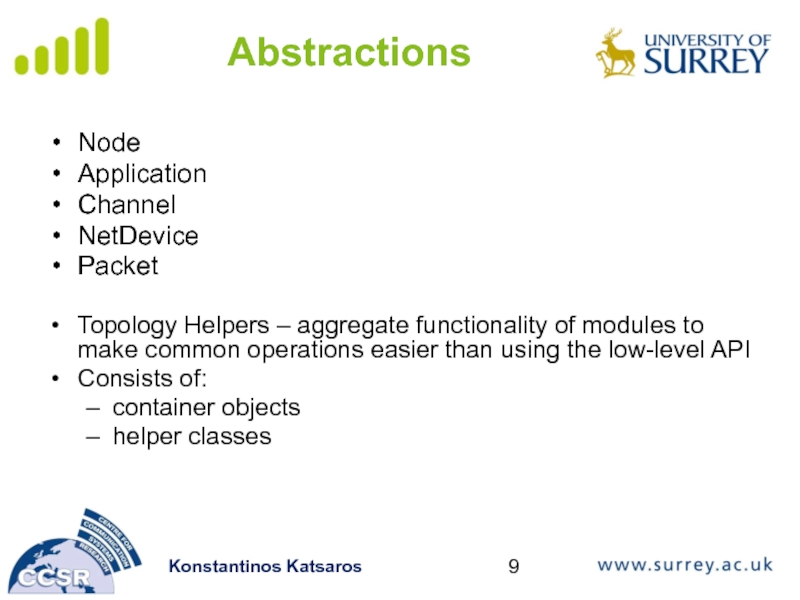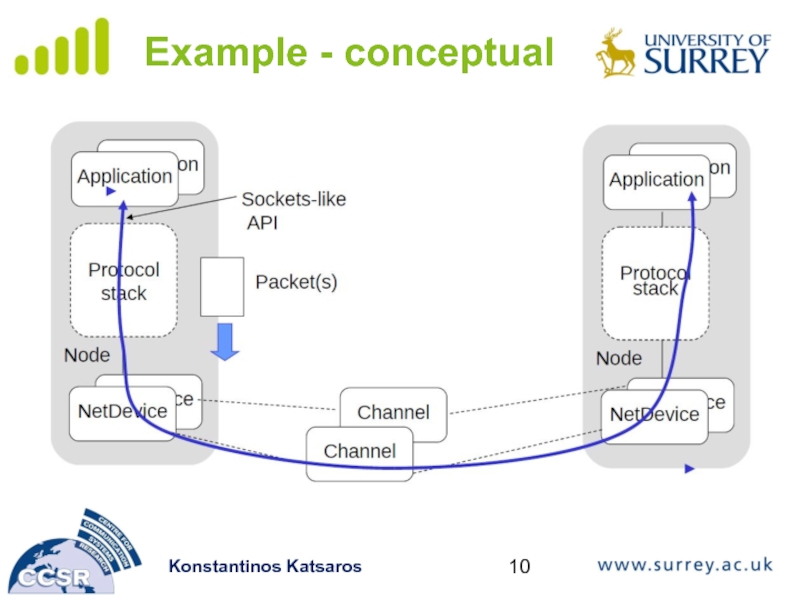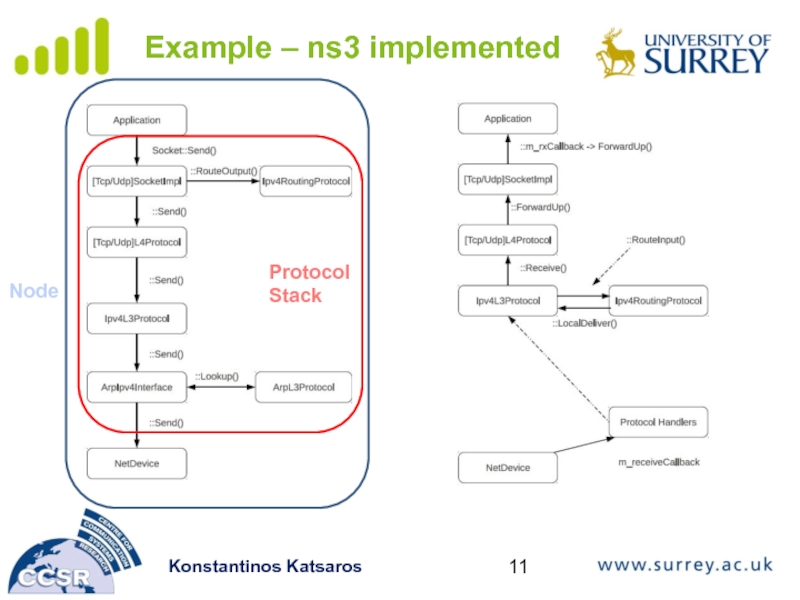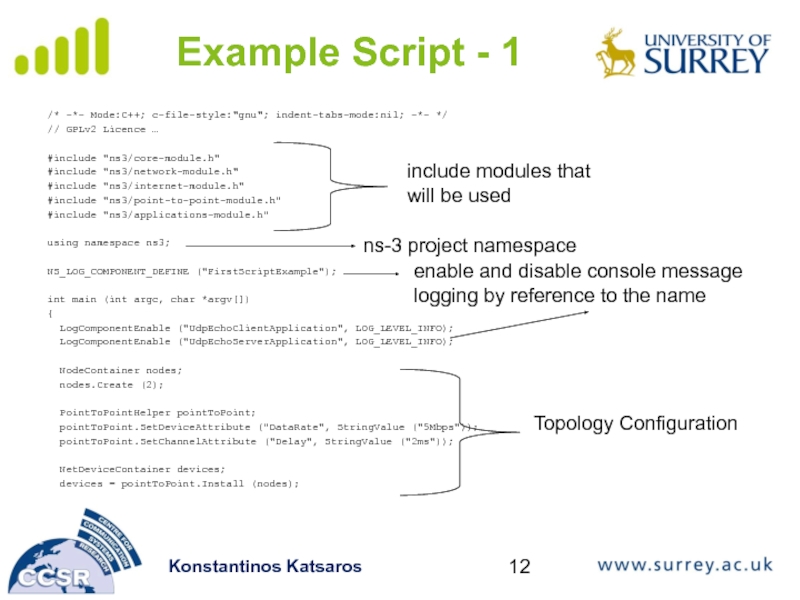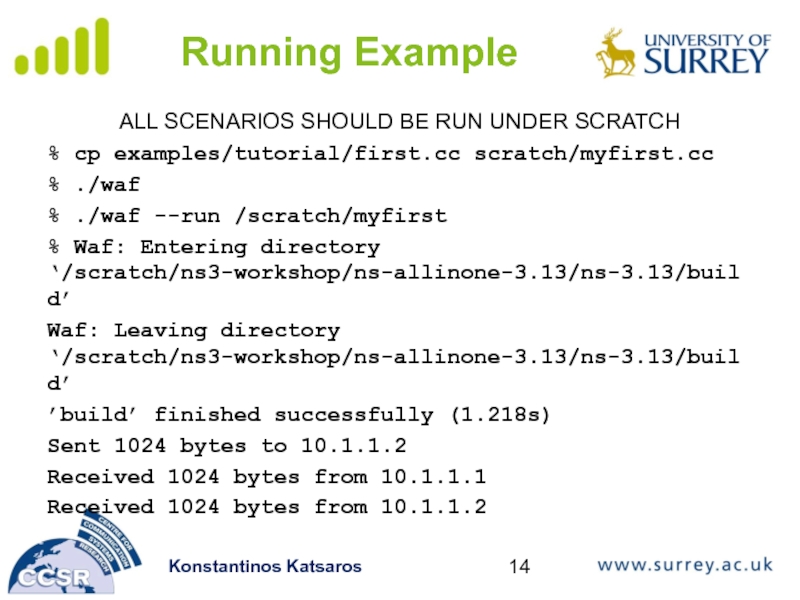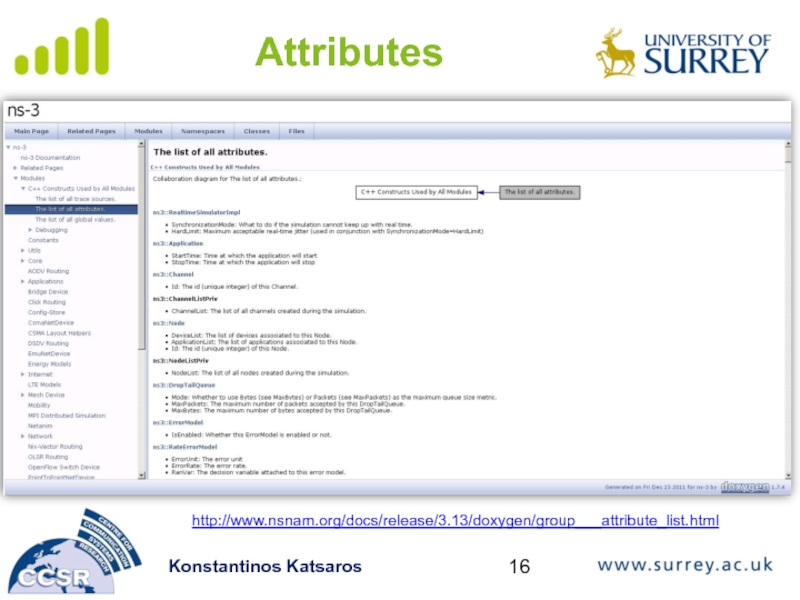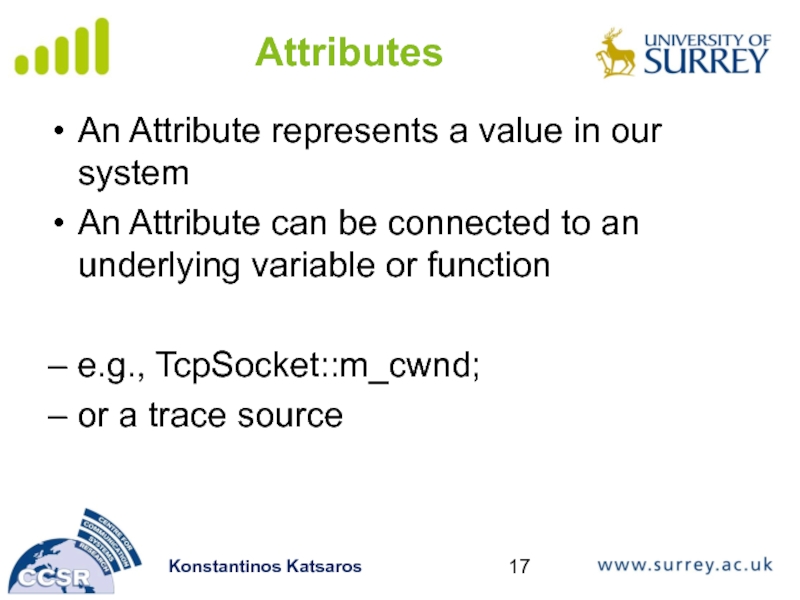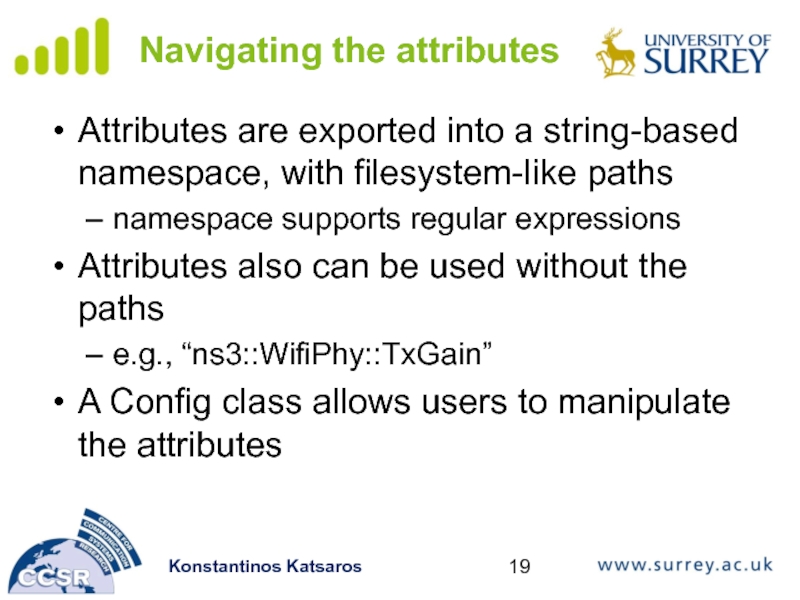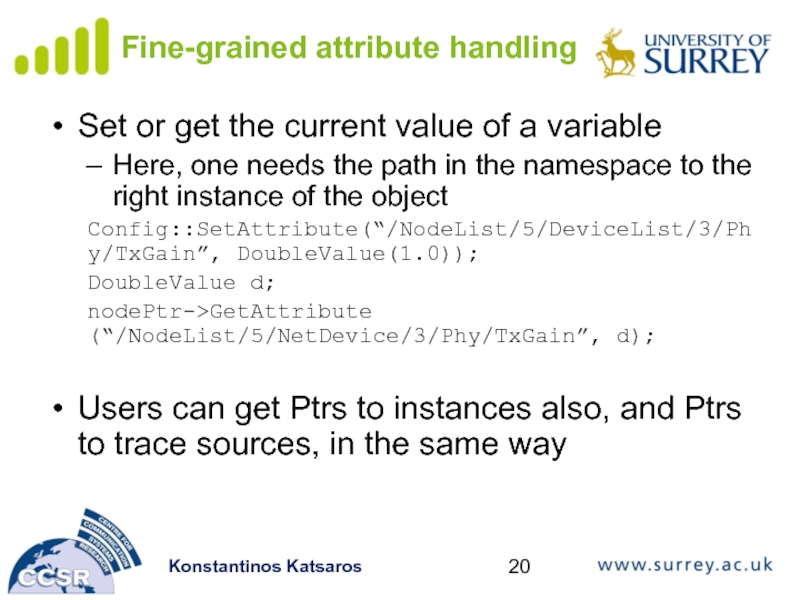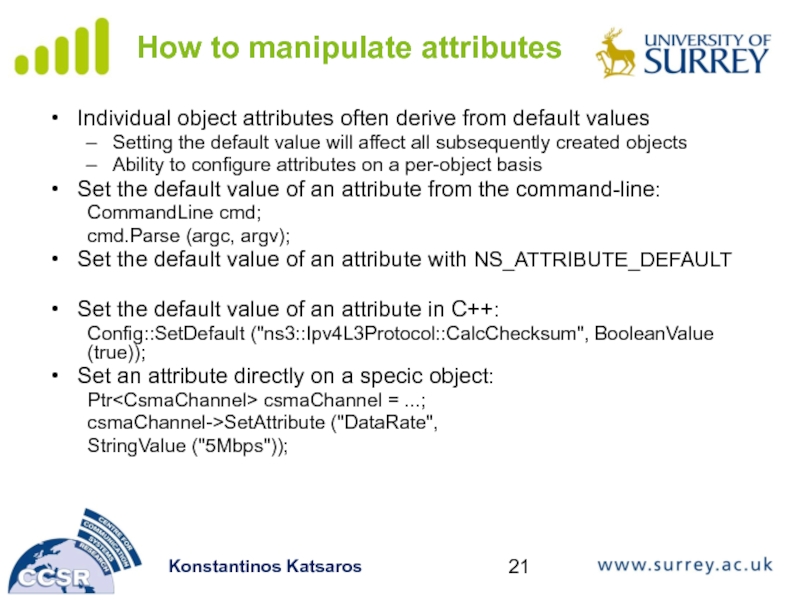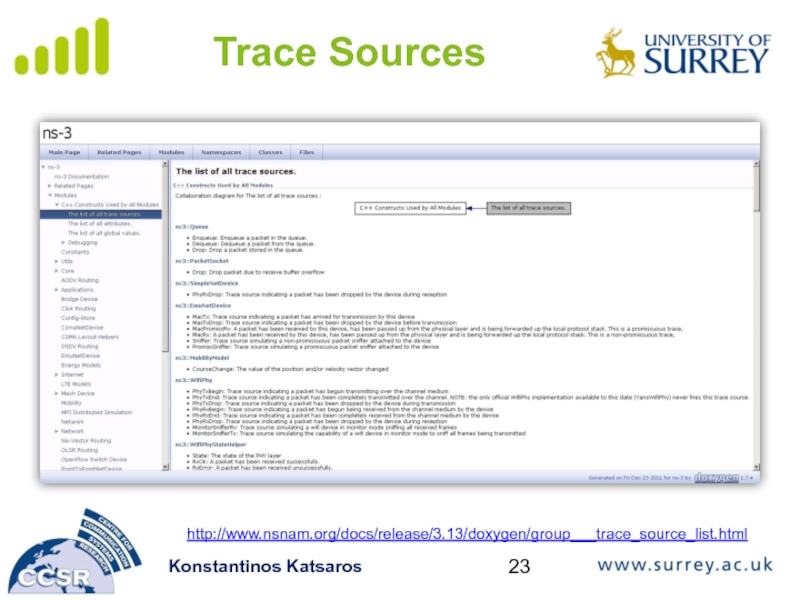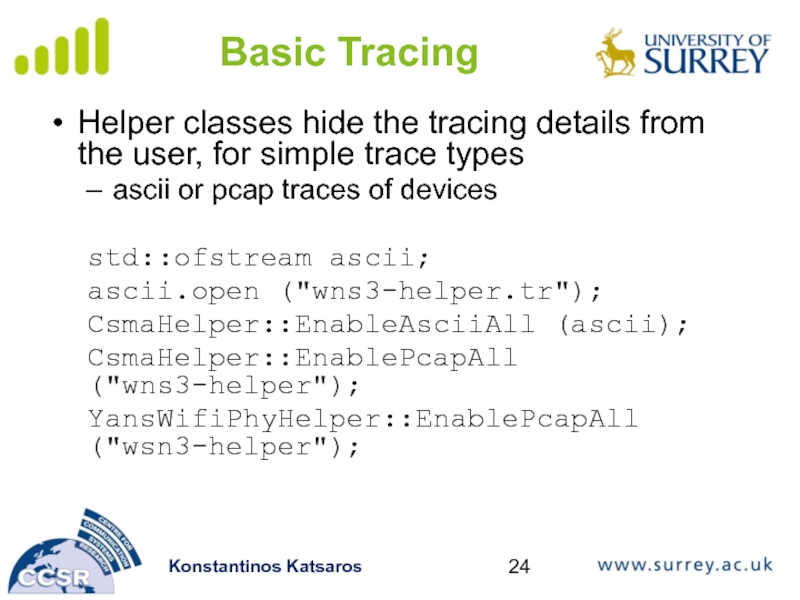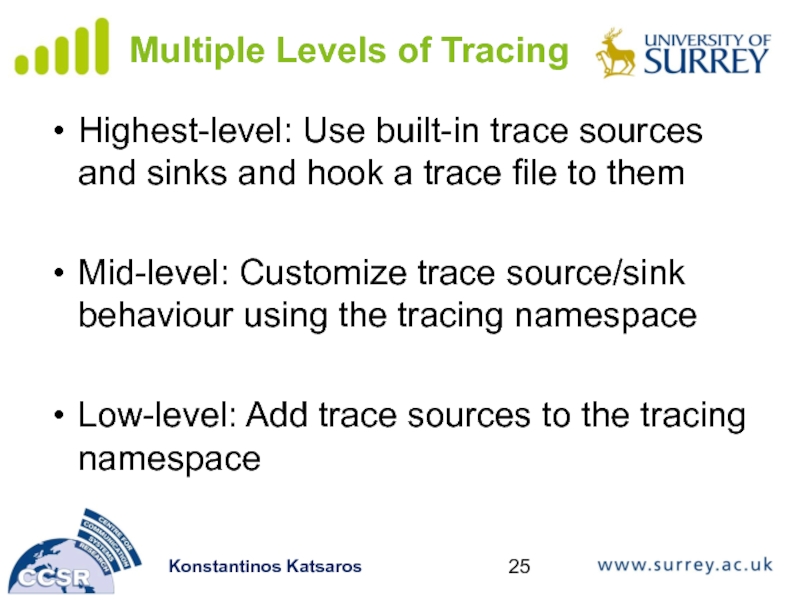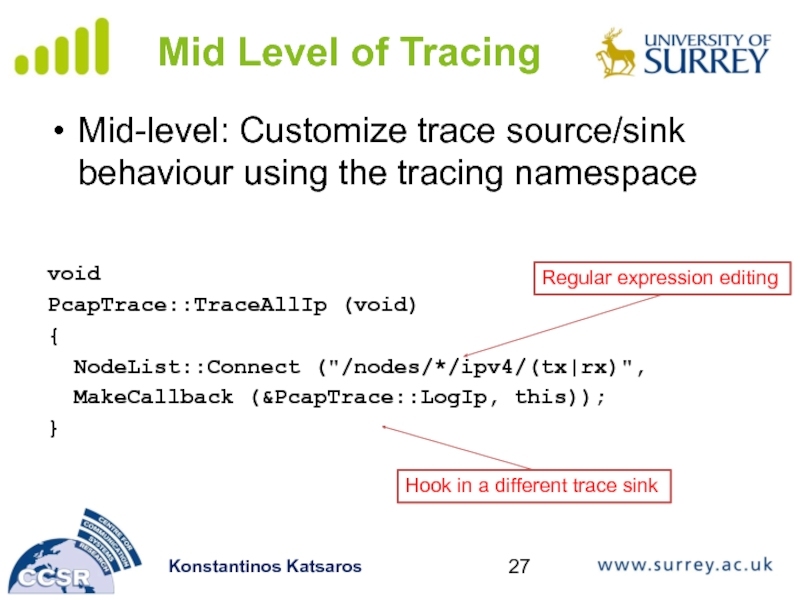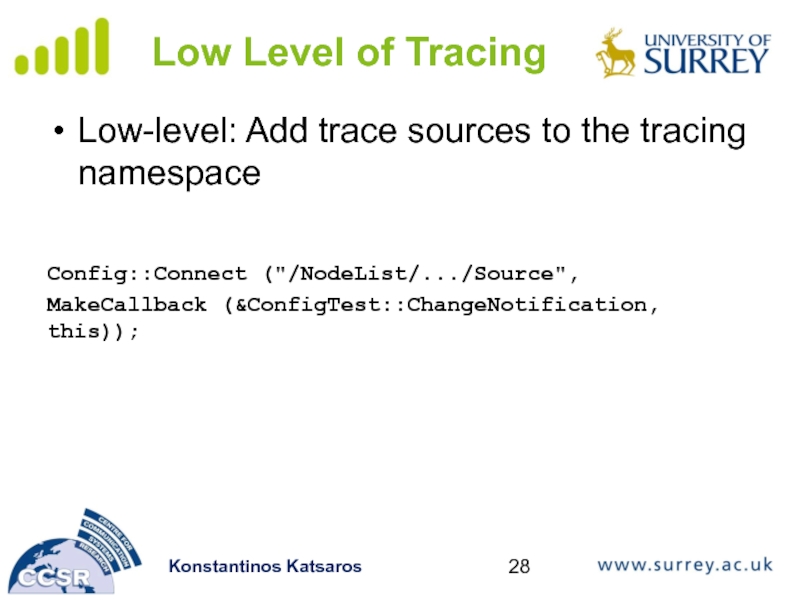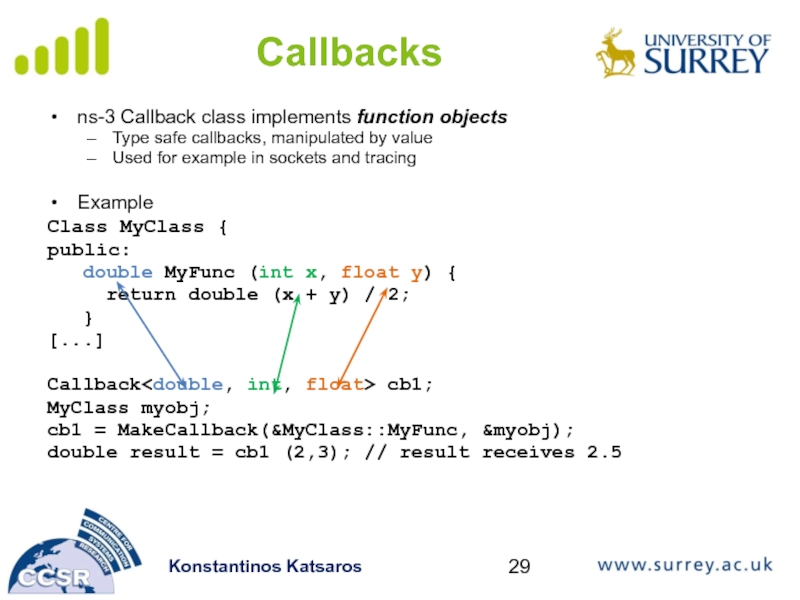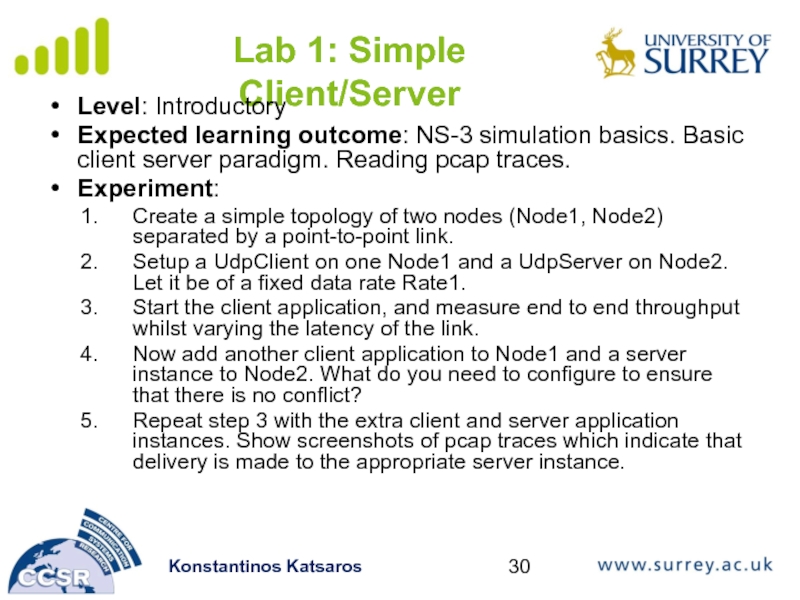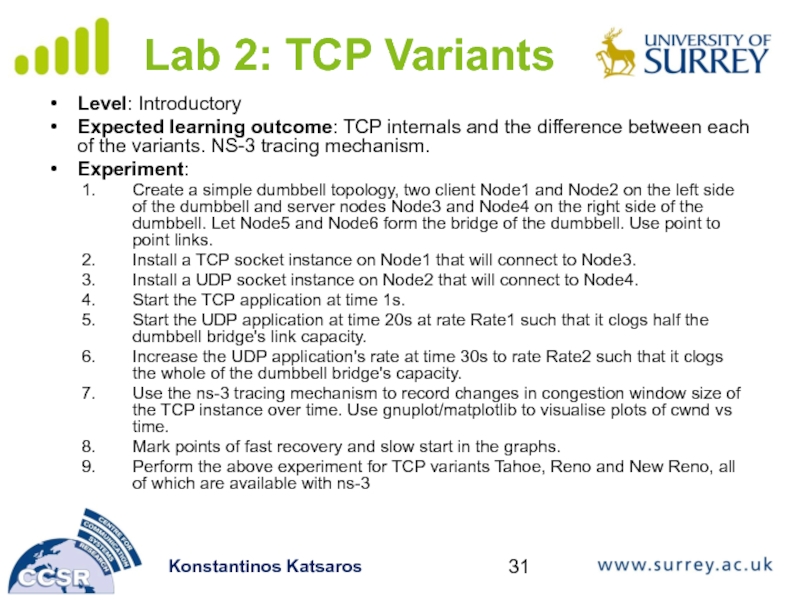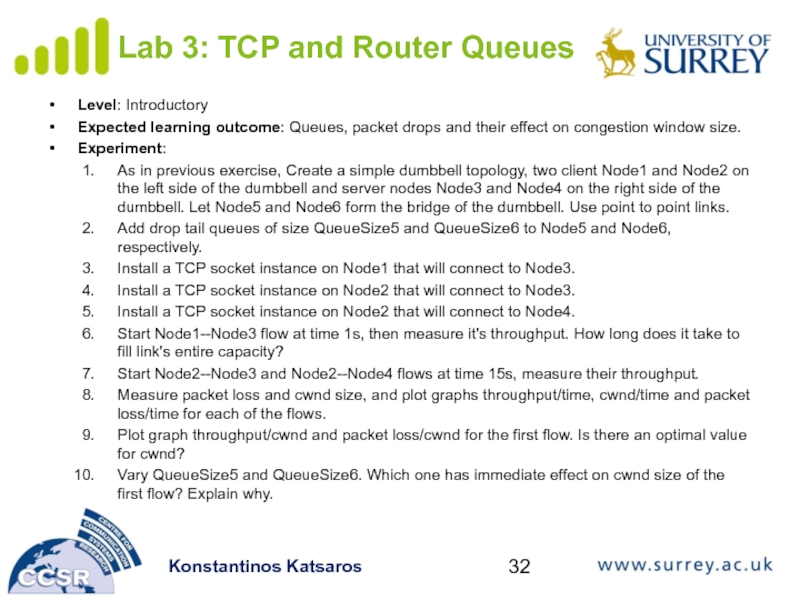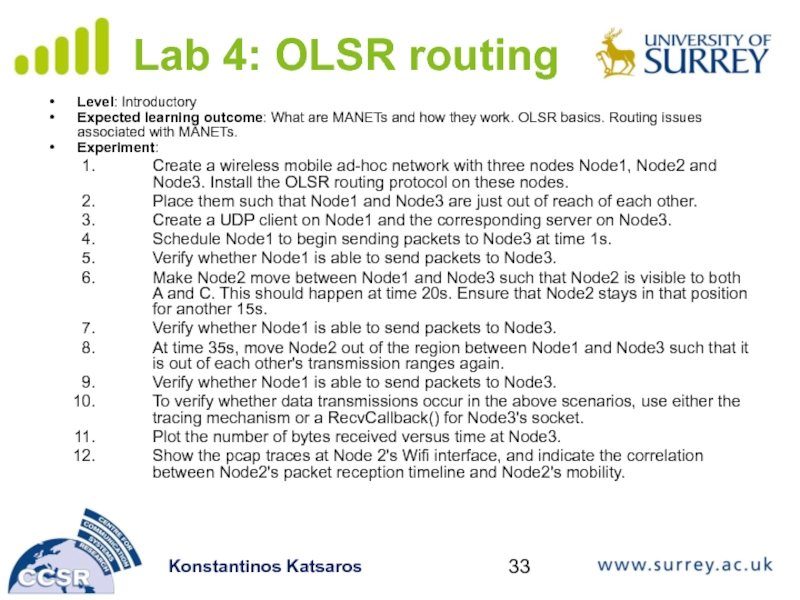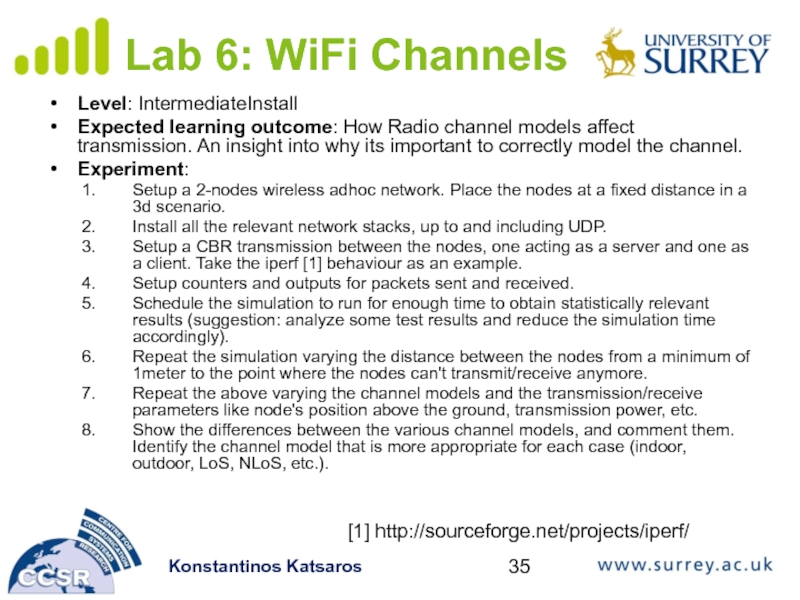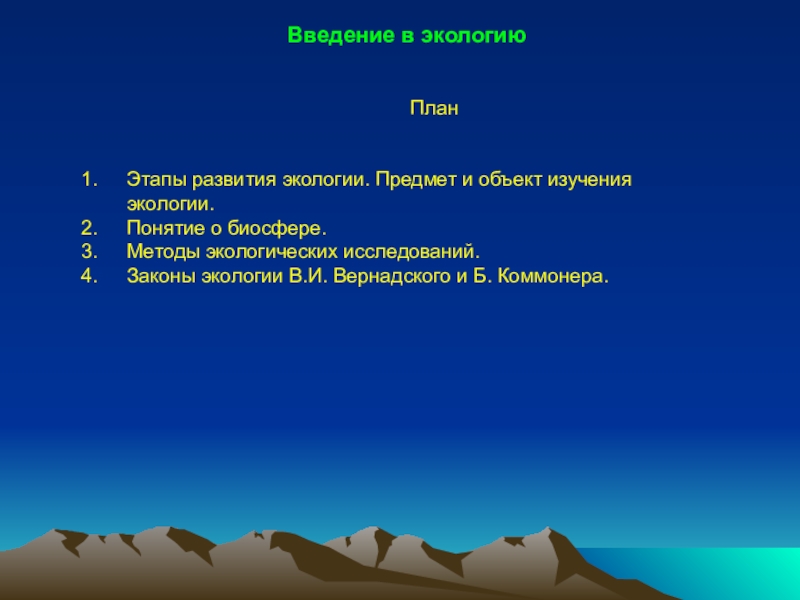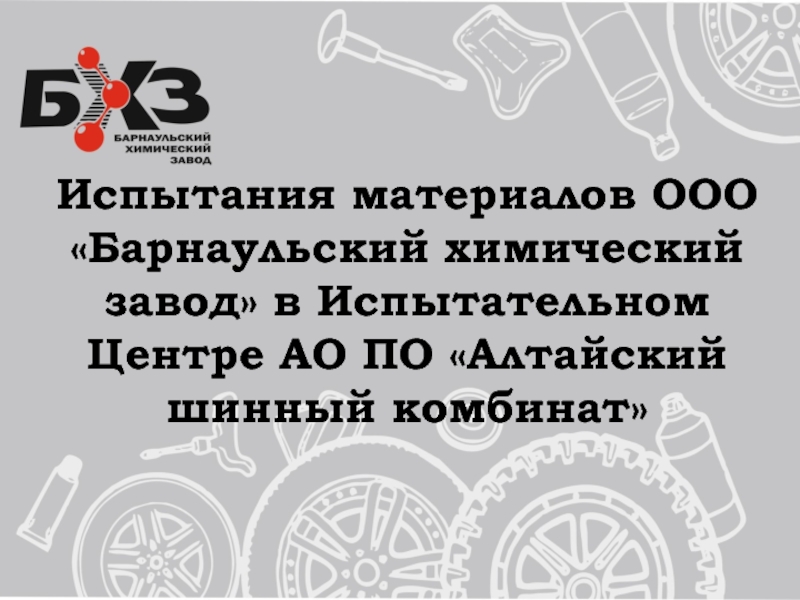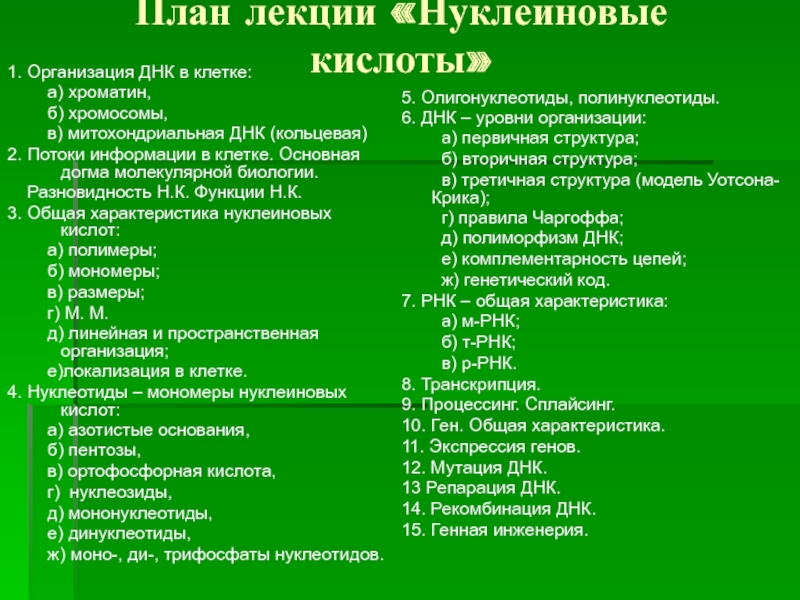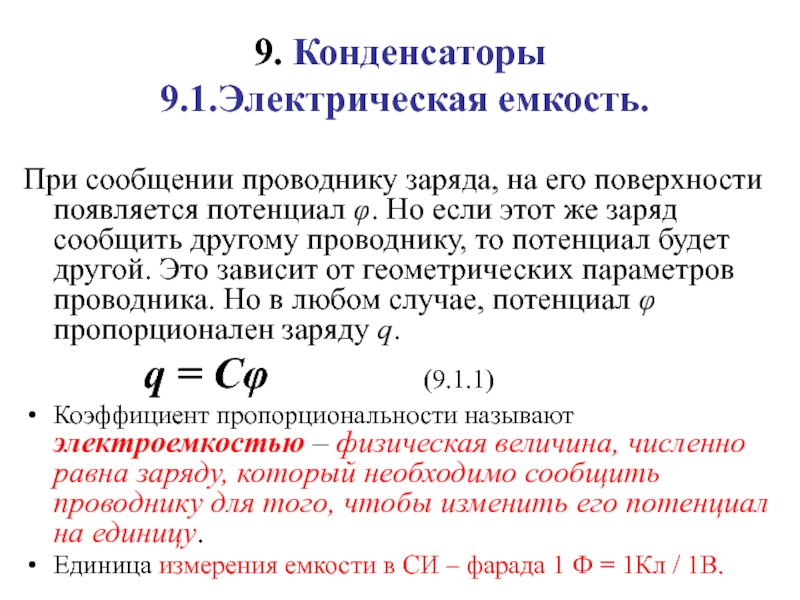Разделы презентаций
- Разное
- Английский язык
- Астрономия
- Алгебра
- Биология
- География
- Геометрия
- Детские презентации
- Информатика
- История
- Литература
- Математика
- Медицина
- Менеджмент
- Музыка
- МХК
- Немецкий язык
- ОБЖ
- Обществознание
- Окружающий мир
- Педагогика
- Русский язык
- Технология
- Физика
- Философия
- Химия
- Шаблоны, картинки для презентаций
- Экология
- Экономика
- Юриспруденция
Introduction to NS-3 Part - 1
Содержание
- 1. Introduction to NS-3 Part - 1
- 2. OverviewNS3 Vs. NS2NS3 FeaturesDownload – Build – UseCurrent ModulesSimulation BasicsAbstractions – Simple example walkthroughAttributesTracingCallbacksExamples-LabResources
- 3. NS3 Vs. NS2ns-2 uses OTcl as its
- 4. NS3 Features (1)Scalability featuresPackets can have ”virtual
- 5. NS3 Features (2)Real world integration featuresPackets can
- 6. Download - Install - UseCross platform (limited
- 7. Current Moduleshttp://www.nsnam.org/docs/release/3.13/models/ns-3-model-library.pdf
- 8. Simulation BasicsSimulation time moves in discrete jumps
- 9. AbstractionsNodeApplicationChannelNetDevicePacketTopology Helpers – aggregate functionality of modules
- 10. Example - conceptual
- 11. Example – ns3 implementedNodeProtocol Stack
- 12. Example Script - 1/* -*- Mode:C++; c-file-style:"gnu";
- 13. Example Script - 2 InternetStackHelper stack;
- 14. Running ExampleALL SCENARIOS SHOULD BE RUN UNDER
- 15. AttributesProblem: Researchers want to identify all of
- 16. Attributeshttp://www.nsnam.org/docs/release/3.13/doxygen/group___attribute_list.html
- 17. AttributesAn Attribute represents a value in our
- 18. How to handle attributesThe traditional C++ way:export
- 19. Navigating the attributesAttributes are exported into a
- 20. Fine-grained attribute handlingSet or get the current
- 21. How to manipulate attributesIndividual object attributes often
- 22. Tracing SystemSimulator provides a set of pre-configured
- 23. Trace Sourceshttp://www.nsnam.org/docs/release/3.13/doxygen/group___trace_source_list.html
- 24. Basic TracingHelper classes hide the tracing details
- 25. Multiple Levels of TracingHighest-level: Use built-in trace
- 26. Highest Level of TracingHighest-level: Use built-in trace
- 27. Mid Level of TracingMid-level: Customize trace source/sink
- 28. Low Level of TracingLow-level: Add trace sources to the tracing namespaceConfig::Connect ("/NodeList/.../Source",MakeCallback (&ConfigTest::ChangeNotification, this));
- 29. Callbacksns-3 Callback class implements function objectsType safe
- 30. Lab 1: Simple Client/ServerLevel: Introductory Expected learning
- 31. Lab 2: TCP VariantsLevel: Introductory Expected learning
- 32. Lab 3: TCP and Router QueuesLevel: Introductory
- 33. Lab 4: OLSR routingLevel: Introductory Expected learning
- 34. Lab 5: WiFi RTS/CTSLevel: Introductory Expected learning
- 35. Lab 6: WiFi ChannelsLevel: IntermediateInstall Expected learning
- 36. Resourceshttp://www.nsnam.org (main website)http://www.nsnam.org/wiki/ (wiki)http://code.nsnam.org/ (source repository)http://groups.google.com/group/ns-3-users (google group)ns-3-users@googlegroups.com (mailing list)
- 37. AcknowledgementsSpecial thanks to:Mathieu LacageTom HendersonGustavo CarneiroFor borrowing parts of their slides
- 38. Thank You!Please fill the following survey after your first experience with NS-3http://info.ee.surrey.ac.uk/Personal/K.Katsaros/ns-3-workshop-survey.htmlSlides are available at:http://info.ee.surrey.ac.uk/Personal/K.Katsaros/ns-3-workshop-part1.htmlhttp://info.ee.surrey.ac.uk/Personal/K.Katsaros/ns-3-workshop-part2.html
- 39. Скачать презентанцию
Слайды и текст этой презентации
Слайд 2Overview
NS3 Vs. NS2
NS3 Features
Download – Build – Use
Current Modules
Simulation Basics
Abstractions
– Simple example walkthrough
Attributes
Tracing
Callbacks
Examples-Lab
Resources
Слайд 3NS3 Vs. NS2
ns-2 uses OTcl as its scripting environment
ns-3 uses
C++ programs or python scripts to define simulations.
simulation programs
are C++ executables or Python programs Python is often a glue language, in practice
ns-3 is a GNU GPLv2-licensed project
ns-3 is not backwards-compatible with ns-2
Some ns-2 models that are mostly written in C++ have already been ported to ns-3. OTcl-based models can not be ported “as is”. Need to re-write.
Слайд 4NS3 Features (1)
Scalability features
Packets can have ”virtual zero bytes” (or
dummy bytes)
For dummy application data that we don't care about
No
memory is allocated for virtual zero bytesReduces the memory footprint of the simulation
Nodes have optional features (sort of AOP)
No memory waste in IPv4 stack for nodes that don't need it
Mobility model may not be needed
E.g. wired netdevices do not need to know the node position at all
New features can be easily added in the future
For example, energy models
Cross-layer features
Packet Tags
Small units of information attached to packets
Tracing
Allow to report events across non-contiguous layers
Слайд 5NS3 Features (2)
Real world integration features
Packets can be saved to
PCAP files, in a real format
Many tools can read PCAP
files, e.g. WiresharkReal-time scheduler
Simulation events synchronized to ”wall clock time”
”Network Simulation Cradle”
Run Linux Kernel TCP/IP stack under simulation
Linux 2.6.18, Linux 2.6.26
POSIX Emulation (experimental)
Run unmodified POSIX programs under simulation
Special ELF loader converts POSIX API calls into NS-3 calls
Running routing daemons on NS-3 (planned)
Слайд 6Download - Install - Use
Cross platform (limited support for Win)
First
download & install ALL dependencies
Simple download and build project…
Current stable
version ns-3.13Run example!!
http://www.nsnam.org/wiki/index.php/Installation
Слайд 8Simulation Basics
Simulation time moves in discrete jumps from event to
event
C++ functions schedule events to occur at specific simulation times
A
simulation scheduler orders the event executionSimulation::Run() gets it all started
Simulation stops at specific time or when events end
Слайд 9Abstractions
Node
Application
Channel
NetDevice
Packet
Topology Helpers – aggregate functionality of modules to make common
operations easier than using the low-level API
Consists of:
container objects
helper classes
Слайд 12Example Script - 1
/* -*- Mode:C++; c-file-style:"gnu"; indent-tabs-mode:nil; -*- */
//
GPLv2 Licence …
#include "ns3/core-module.h"
#include "ns3/network-module.h"
#include "ns3/internet-module.h"
#include "ns3/point-to-point-module.h"
#include "ns3/applications-module.h"
using namespace ns3;
NS_LOG_COMPONENT_DEFINE
("FirstScriptExample");int main (int argc, char *argv[])
{
LogComponentEnable ("UdpEchoClientApplication", LOG_LEVEL_INFO);
LogComponentEnable ("UdpEchoServerApplication", LOG_LEVEL_INFO);
NodeContainer nodes;
nodes.Create (2);
PointToPointHelper pointToPoint;
pointToPoint.SetDeviceAttribute ("DataRate", StringValue ("5Mbps"));
pointToPoint.SetChannelAttribute ("Delay", StringValue ("2ms"));
NetDeviceContainer devices;
devices = pointToPoint.Install (nodes);
include modules that will be used
ns-3 project namespace
enable and disable console message logging by reference to the name
Topology Configuration
Слайд 13Example Script - 2
InternetStackHelper stack;
stack.Install (nodes);
Ipv4AddressHelper
address;
address.SetBase ("10.1.1.0", "255.255.255.0");
Ipv4InterfaceContainer interfaces = address.Assign (devices);
UdpEchoServerHelper
echoServer (9);ApplicationContainer serverApps = echoServer.Install (nodes.Get (1));
serverApps.Start (Seconds (1.0));
serverApps.Stop (Seconds (10.0));
UdpEchoClientHelper echoClient (interfaces.GetAddress (1), 9);
echoClient.SetAttribute ("MaxPackets", UintegerValue (1));
echoClient.SetAttribute ("Interval", TimeValue (Seconds (1.0)));
echoClient.SetAttribute ("PacketSize", UintegerValue (1024));
ApplicationContainer clientApps = echoClient.Install (nodes.Get (0));
clientApps.Start (Seconds (2.0));
clientApps.Stop (Seconds (10.0));
Simulator::Run ();
Simulator::Destroy ();
return 0;
}
Set up internet stack
Set up applications
Run the simulation
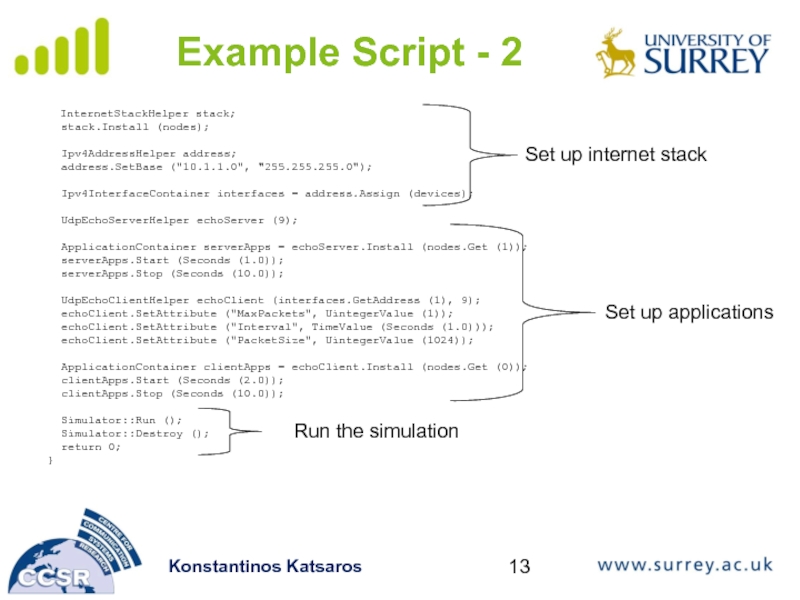
Слайд 14Running Example
ALL SCENARIOS SHOULD BE RUN UNDER SCRATCH
% cp examples/tutorial/first.cc
scratch/myfirst.cc
% ./waf
% ./waf --run /scratch/myfirst
% Waf: Entering directory ‘/scratch/ns3-workshop/ns-allinone-3.13/ns-3.13/build’
Waf: Leaving
directory ‘/scratch/ns3-workshop/ns-allinone-3.13/ns-3.13/build’’build’ finished successfully (1.218s)
Sent 1024 bytes to 10.1.1.2
Received 1024 bytes from 10.1.1.1
Received 1024 bytes from 10.1.1.2
Слайд 15Attributes
Problem: Researchers want to identify all of the values affecting
the results of their simulations and configure them easily
ns-3 solution:
Each ns-3 object has a set of attributes:A name, help text
A type
An initial value
Control all simulation parameters for static objects
Dump and read them all in configuration files
Visualize them in a GUI
Makes it easy to verify the parameters of a simulation
Слайд 17Attributes
An Attribute represents a value in our system
An Attribute can
be connected to an underlying variable or function
– e.g., TcpSocket::m_cwnd;
–
or a trace sourceСлайд 18How to handle attributes
The traditional C++ way:
export attributes as part
of a class's public API
walk pointer chains (and iterators, when
needed) to find what you needuse static variables for defaults
The attribute system provides a more convenient API to the user to do these things
Слайд 19Navigating the attributes
Attributes are exported into a string-based namespace, with
filesystem-like paths
namespace supports regular expressions
Attributes also can be used without
the pathse.g., “ns3::WifiPhy::TxGain”
A Config class allows users to manipulate the attributes
Слайд 20Fine-grained attribute handling
Set or get the current value of a
variable
Here, one needs the path in the namespace to the
right instance of the objectConfig::SetAttribute(“/NodeList/5/DeviceList/3/Phy/TxGain”, DoubleValue(1.0));
DoubleValue d;
nodePtr->GetAttribute (“/NodeList/5/NetDevice/3/Phy/TxGain”, d);
Users can get Ptrs to instances also, and Ptrs to trace sources, in the same way
Слайд 21How to manipulate attributes
Individual object attributes often derive from default
values
Setting the default value will affect all subsequently created objects
Ability
to configure attributes on a per-object basisSet the default value of an attribute from the command-line:
CommandLine cmd;
cmd.Parse (argc, argv);
Set the default value of an attribute with NS_ATTRIBUTE_DEFAULT
Set the default value of an attribute in C++:
Config::SetDefault ("ns3::Ipv4L3Protocol::CalcChecksum", BooleanValue (true));
Set an attribute directly on a specic object:
Ptr
csmaChannel->SetAttribute ("DataRate",
StringValue ("5Mbps"));
Слайд 22Tracing System
Simulator provides a set of pre-configured trace sources
Users may
edit the core to add their own
Users provide trace sinks
and attach to the trace sourceSimulator core provides a few examples for common cases
Multiple trace sources can connect to a trace sink
Слайд 24Basic Tracing
Helper classes hide the tracing details from the user,
for simple trace types
ascii or pcap traces of devices
std::ofstream ascii;
ascii.open
("wns3-helper.tr");CsmaHelper::EnableAsciiAll (ascii);
CsmaHelper::EnablePcapAll ("wns3-helper");
YansWifiPhyHelper::EnablePcapAll ("wsn3-helper");
Слайд 25Multiple Levels of Tracing
Highest-level: Use built-in trace sources and sinks
and hook a trace file to them
Mid-level: Customize trace source/sink
behaviour using the tracing namespaceLow-level: Add trace sources to the tracing namespace
Слайд 26Highest Level of Tracing
Highest-level: Use built-in trace sources and sinks
and hook a trace file to them
// Also configure some
tcpdump traces; each interface // will be traced. // The output files will be named:
// simple-point-to-point.pcap-
// and can be read by the "tcpdump -r" command (use "-// tt" option to display timestamps correctly)
PcapTrace pcaptrace ("simple-point-to-point.pcap");
pcaptrace.TraceAllIp ();
Слайд 27Mid Level of Tracing
Mid-level: Customize trace source/sink behaviour using the
tracing namespace
void
PcapTrace::TraceAllIp (void)
{
NodeList::Connect ("/nodes/*/ipv4/(tx|rx)",
MakeCallback (&PcapTrace::LogIp, this));
}
Hook in a
different trace sinkRegular expression editing
Слайд 28Low Level of Tracing
Low-level: Add trace sources to the tracing
namespace
Config::Connect ("/NodeList/.../Source",
MakeCallback (&ConfigTest::ChangeNotification, this));
Слайд 29Callbacks
ns-3 Callback class implements function objects
Type safe callbacks, manipulated by
value
Used for example in sockets and tracing
Example
Class MyClass {
public:
double MyFunc (int x, float y) {return double (x + y) / 2;
}
[...]
Callback
MyClass myobj;
cb1 = MakeCallback(&MyClass::MyFunc, &myobj);
double result = cb1 (2,3); // result receives 2.5
Слайд 30Lab 1: Simple Client/Server
Level: Introductory
Expected learning outcome: NS-3 simulation
basics. Basic client server paradigm. Reading pcap traces.
Experiment:
Create
a simple topology of two nodes (Node1, Node2) separated by a point-to-point link. Setup a UdpClient on one Node1 and a UdpServer on Node2. Let it be of a fixed data rate Rate1.
Start the client application, and measure end to end throughput whilst varying the latency of the link.
Now add another client application to Node1 and a server instance to Node2. What do you need to configure to ensure that there is no conflict?
Repeat step 3 with the extra client and server application instances. Show screenshots of pcap traces which indicate that delivery is made to the appropriate server instance.
Слайд 31Lab 2: TCP Variants
Level: Introductory
Expected learning outcome: TCP internals
and the difference between each of the variants. NS-3 tracing
mechanism.Experiment:
Create a simple dumbbell topology, two client Node1 and Node2 on the left side of the dumbbell and server nodes Node3 and Node4 on the right side of the dumbbell. Let Node5 and Node6 form the bridge of the dumbbell. Use point to point links.
Install a TCP socket instance on Node1 that will connect to Node3.
Install a UDP socket instance on Node2 that will connect to Node4.
Start the TCP application at time 1s.
Start the UDP application at time 20s at rate Rate1 such that it clogs half the dumbbell bridge's link capacity.
Increase the UDP application's rate at time 30s to rate Rate2 such that it clogs the whole of the dumbbell bridge's capacity.
Use the ns-3 tracing mechanism to record changes in congestion window size of the TCP instance over time. Use gnuplot/matplotlib to visualise plots of cwnd vs time.
Mark points of fast recovery and slow start in the graphs.
Perform the above experiment for TCP variants Tahoe, Reno and New Reno, all of which are available with ns-3
Слайд 32Lab 3: TCP and Router Queues
Level: Introductory
Expected learning outcome:
Queues, packet drops and their effect on congestion window size.
Experiment:
As in previous exercise, Create a simple dumbbell topology, two client Node1 and Node2 on the left side of the dumbbell and server nodes Node3 and Node4 on the right side of the dumbbell. Let Node5 and Node6 form the bridge of the dumbbell. Use point to point links.
Add drop tail queues of size QueueSize5 and QueueSize6 to Node5 and Node6, respectively.
Install a TCP socket instance on Node1 that will connect to Node3.
Install a TCP socket instance on Node2 that will connect to Node3.
Install a TCP socket instance on Node2 that will connect to Node4.
Start Node1--Node3 flow at time 1s, then measure it's throughput. How long does it take to fill link's entire capacity?
Start Node2--Node3 and Node2--Node4 flows at time 15s, measure their throughput.
Measure packet loss and cwnd size, and plot graphs throughput/time, cwnd/time and packet loss/time for each of the flows.
Plot graph throughput/cwnd and packet loss/cwnd for the first flow. Is there an optimal value for cwnd?
Vary QueueSize5 and QueueSize6. Which one has immediate effect on cwnd size of the first flow? Explain why.
Слайд 33Lab 4: OLSR routing
Level: Introductory
Expected learning outcome: What are
MANETs and how they work. OLSR basics. Routing issues associated
with MANETs.Experiment:
Create a wireless mobile ad-hoc network with three nodes Node1, Node2 and Node3. Install the OLSR routing protocol on these nodes.
Place them such that Node1 and Node3 are just out of reach of each other.
Create a UDP client on Node1 and the corresponding server on Node3.
Schedule Node1 to begin sending packets to Node3 at time 1s.
Verify whether Node1 is able to send packets to Node3.
Make Node2 move between Node1 and Node3 such that Node2 is visible to both A and C. This should happen at time 20s. Ensure that Node2 stays in that position for another 15s.
Verify whether Node1 is able to send packets to Node3.
At time 35s, move Node2 out of the region between Node1 and Node3 such that it is out of each other's transmission ranges again.
Verify whether Node1 is able to send packets to Node3.
To verify whether data transmissions occur in the above scenarios, use either the tracing mechanism or a RecvCallback() for Node3's socket.
Plot the number of bytes received versus time at Node3.
Show the pcap traces at Node 2's Wifi interface, and indicate the correlation between Node2's packet reception timeline and Node2's mobility.
Слайд 34Lab 5: WiFi RTS/CTS
Level: Introductory
Expected learning outcome: How 802.11
works with and without RTS/CTS. An insight into why its
hard to setup efficient wireless networks.Experiment:
Setup a 5x5 wireless adhoc network with a grid. You may use examples/wireless/wifi-simple-adhoc-grid.cc as a base.
Install the OLSR routing protocol.
Setup three UDP traffic flows, one along each diagonal and one along the middle (at high rates of transmission).
Setup the ns-3 flow monitor for each of these flows.
Now schedule each of the flows at times 1s, 1.5s, and 2s.
Now using the flow monitor, observe the throughput of each of the UDP flows. Furthermore, use the tracing mechanism to monitor the number of packet collisions/drops at intermediary nodes. Around which nodes are most of the collisions/drops happening?
Now repeat the experiment with RTS/CTS enabled on the wifi devices.
Show the difference in throughput and packet drops if any.
Слайд 35Lab 6: WiFi Channels
Level: IntermediateInstall
Expected learning outcome: How Radio
channel models affect transmission. An insight into why its important
to correctly model the channel.Experiment:
Setup a 2-nodes wireless adhoc network. Place the nodes at a fixed distance in a 3d scenario.
Install all the relevant network stacks, up to and including UDP.
Setup a CBR transmission between the nodes, one acting as a server and one as a client. Take the iperf [1] behaviour as an example.
Setup counters and outputs for packets sent and received.
Schedule the simulation to run for enough time to obtain statistically relevant results (suggestion: analyze some test results and reduce the simulation time accordingly).
Repeat the simulation varying the distance between the nodes from a minimum of 1meter to the point where the nodes can't transmit/receive anymore.
Repeat the above varying the channel models and the transmission/receive parameters like node's position above the ground, transmission power, etc.
Show the differences between the various channel models, and comment them. Identify the channel model that is more appropriate for each case (indoor, outdoor, LoS, NLoS, etc.).
[1] http://sourceforge.net/projects/iperf/
Слайд 36Resources
http://www.nsnam.org (main website)
http://www.nsnam.org/wiki/ (wiki)
http://code.nsnam.org/ (source repository)
http://groups.google.com/group/ns-3-users (google group)
ns-3-users@googlegroups.com (mailing list)
Слайд 37Acknowledgements
Special thanks to:
Mathieu Lacage
Tom Henderson
Gustavo Carneiro
For borrowing parts of their
slides
Слайд 38Thank You!
Please fill the following survey after your first experience
with NS-3
http://info.ee.surrey.ac.uk/Personal/K.Katsaros/ns-3-workshop-survey.html
Slides are available at:
http://info.ee.surrey.ac.uk/Personal/K.Katsaros/ns-3-workshop-part1.html
http://info.ee.surrey.ac.uk/Personal/K.Katsaros/ns-3-workshop-part2.html
Обратная связь
Если не удалось найти и скачать доклад-презентацию, Вы можете заказать его на нашем сайте. Мы постараемся найти нужный Вам материал и отправим по электронной почте. Не стесняйтесь обращаться к нам, если у вас возникли вопросы или пожелания:
Email: Нажмите что бы посмотреть
